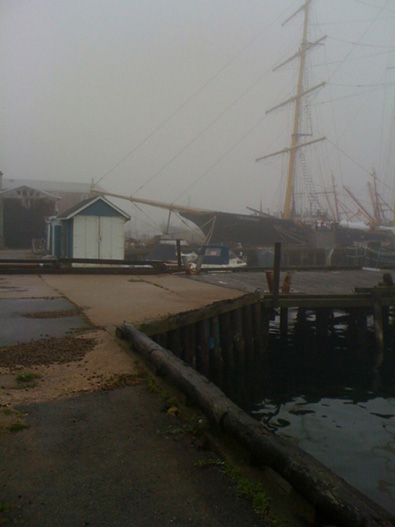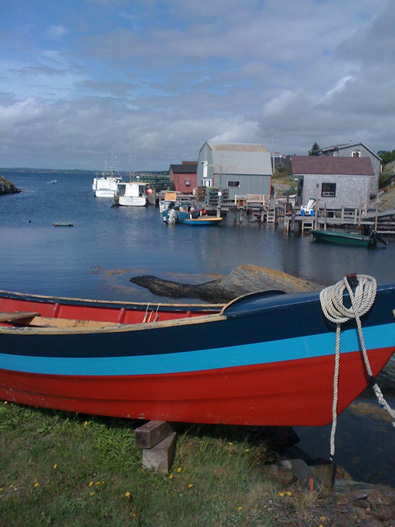Professors: Ricardo L. Castro and David Covo
Place: Lunenburg, Nova Scotia
Dates: Thursday, August 19 to Thursday, August 26, 2010
NOTE: We were at one time considering a Saturday-Saturday schedule (August 21-28), and finally decided to stay with the traditional program, but not before the Saturday-Saturday schedule was published on Minerva. So if you have already booked and are unable to change, please do not worry. We will adapt the program for the later arrival and departure of some of the group. In other words, we will work around your schedules.
ARCH 324, Sketching School:
An eight-day supervised field trip in the late summer to sketch places or things having specific visual characteristics. (Students are required to include Sketching School (ARCH 324) in the B.Sc.(Arch.).)
ARCH 680, Field Sketching:
Observation, notebook recording, sketching in a range of media in the field in Montreal and other urban sites. Eight days of supervised field sketching outside Montreal, followed by local fieldwork and coursework examining architectural sketching as a process that develops an intellectual and physical framework for encounters with the urban environment. (Students newly admitted to the M.Arch. (Prof.) Design Studio concentration are required to take Field Sketching (ARCH 680) right away. Students in the M.Arch. (Prof.)-Design Studio Directed Research may also take it as an architectural complementary. Please see further details provided at the end of the document).


Accommodation
A wide range of hotels, motels and inns are available and students are expected to arrange their own accommodation. Google will provide you with a full list of inns, hotels, motels, B & B, chalet rentals and campgrounds.
A printed information package from the Lunenburg tourist website will be available, for viewing only, on the front counter, Room 201.
PLEASE NOTE: LUNENBURG IS A VERY POPULAR HOLIDAY DESTINATION. PLEASE RESERVE EARLY!

Transportation
A variety of travel choices are available to students. The School has looked into the best economical way to travel: it is by car or van. However, some of you may wish to travel by Via Rail, from Montreal to Halifax. The telephone number is (514) 989-2626. The cost for a student for a round trip student fare ticket is $366.20, including taxes. In order to obtain this fare, a student must have an ISIC Card which can be obtained from Via Rail or Travel Cuts Voyage Campus, McGill; proof of registration is required, i.e. receipt of tuition fee payment, or confirmation letter from McGill University’s Registrar’s Office. The train departs from Montreal every day except Tuesdays, at 6:30 p.m., arriving at Halifax at 5:10 p.m. the following day. Trius Tours provides bus transportation from Halifax Via Rail Station to Lunenburg, every day at.5:30 p.m., arriving at Lunenburg at 7:05 p.m. One way fare is $20 for students, and return fare $34.
Returning from Lunenburg to Montreal: Trius Tours departs Lunenburg on Monday to Saturdays at 10:55 a.m., and on Sundays and holidays at 2:55 p.m. The train departs from the Halifax Via Rail train station on every day except Tuesdays, at 12:15 p.m. and arrives in Montreal the following day at 9:05 a.m.
NOTE: Train or plane travel is very popular at this time of year. Please book your tickets as quickly as possible. If you are planning to travel by train/bus, can you please send a quick mary.lanni [at] mcgill.ca (e-mail) to Mary Lanni-Campoli no later than August 9, 2010. Trius tours would like to know how many students may possibly need to take their bus.

Health Insurance
Please remember to bring with you the Quebec Medicare Card, and/or proof of any other supplementary health insurance you may have.
Required Equipment
Water colours, water colour paper, brushes, pencils, pen and ink, conte crayon, sketch books and drawing paper of varying sizes and types. Sketch pads, sheet material and watercolour blocks should range from 9" x 12" to 18" x 24".
If you haven’t yet covered watercolour in Freehand Drawing, and need to buy a set of watercolours, you could consider a set with "cakes," or you could purchase separate tubes of pigment. If you decide to buy the separate tubes, you will need to develop a versatile palette. Below is one suggestion for a 12-colour palette - please note that the palette does NOT include black or white, which are unnecessary and even undesirable.
- Reds: Alizarin Crimson, Indian Red
- Blues: French Ultramarine, Cobalt Blue
- Yellows (difficult): Cadmium Yellow Pale, Yellow Ochre
- Greens: Hooker’s Green Dark, Olive Green
- Browns: Burnt Umber, Burnt Sienna, Raw Umber
- Other: Payne’s Grey
The first experiments in watercolour will be based only on French Ultramarine and Burnt Umber, which produce a surprising range of values and colours.
As for sketchbooks and pads, we recommend, in addition to the list above, a small pocket notebook or sketchpad for thumbnail sketches and experiments with wash and watercolour. A few good sable or synthetic brushes will also be required: a small and medium round, with a medium to large (1/2 inch or 3/4 inch) flat are always useful.
Bicycles have always been valuable additions to the standard "kit" and are highly recommended. We have also found that a folding camp stool or small foam pad can make 2 to 3 hours on the cold ground much more endurable.
Schedule and Meeting Format
The emphasis is on field sketching as opposed to studio work, so students draw outside every day, working individually and in small groups, and under the supervision of the instructors for the first four mornings of the course.
Our first meeting – a short one to orient everyone and coordinate the time and place of the first workshop - will be at 6:30 p.m., Thursday, August 19, on the Bluenose II dock, across the street from 121 Bluenose Drive.
Four other meetings – these are discussions of the work being produced – will take place between 6:30 p.m. and 8:00 p.m. on the following days:
- Meeting 1: Friday, August 20
- Meeting 2: Sunday, August 22
- Meeting 3: Tuesday, August 24
- Meeting 4: Thursday, August 26
LOCATION:
The Parish Hall of St. John’s Anglican Church,
64 Townsend Street
These 90-minute sessions provide a forum not only for a review of the work but also for informal discussions on the intentions of the course and on the process by which images and memories are formed.
Please visit this webpage for any changes to schedule and meeting places.
Morning Workshops
There will be three morning workshops for Sketching School (Field Sketching is welcome to attend). The first workshop will take place on Saturday morning, August 21, on the Bluenose II dock, across the street from 121 Bluenose Drive.
Evaluation
During the course, students are expected to explore both townscape and landscape and to make sketches that describe what they find. Final evaluation is based on a portfolio of at least twenty pieces, the majority of which must be substantially worked. All portfolios must be left in the freehand drawing room, (one pile for Sketching School - ARCH 324 - and another for Field Sketching - ARCH 680) by 1000 hrs on Wednesday, September 1, 2010.
Registration
Students currently registered in the B.Sc.(Arch.) program are required to attend ARCH 324 Sketching School. Registration for ARCH 324 is possible until August 1, 2010, via MINERVA – Summer 2010 term.
Newly admitted students to the M.Arch. (Prof.) Design Studio program will register for ARCH 680 Field Sketching with the remaining courses required in the Fall 2010 term.
If registration (including withdrawals) is problematic, please contact Mary Lanni-Campoli by mary.lanni [at] mcgill.ca (e-mail) or by telephone at (514) 398-6702 before the commencement of Sketching School/Field Sketching.